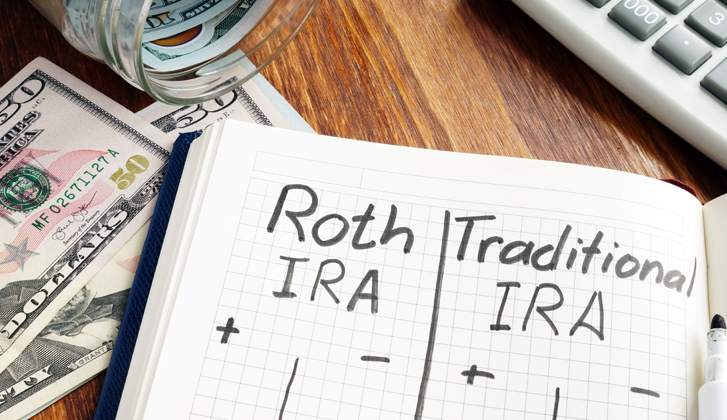NOTICE: Internet Explorer was retired by Microsoft on June 15th, 2022 and is no longer supported. This could change how you access Online Banking.
Our banking centers close at 12pm on 12/24 through Christmas Day. Transactions scheduled at that time will be processed the next business day.
How to Save for Retirement in 9 Easy Steps

Retirement may seem like a lifetime away, but it’s a milestone we all hope to reach at some point. Saving for retirement is essential to have a long and comfortable life after you leave the workforce. However, it’s not easy to determine where to start or how to save more for retirement.
The numbers can be intimidating and the longevity of this kind of savings plan can seem insurmountable. But there is an easy part. Your retirement savings plan is completely up to you and your own financial goals. To make it even easier, we’ve put together a list of retirement savings strategies you can start now to save more for retirement.
Retirement Savings Tips
1. Create a Savings Mindset
The first step to building a retirement savings plan is creating a savings mindset. It’s never a good idea to spend your paychecks away every month. Start with a holistic view of your spending. Separate out critical living expenses from entertainment, shopping and any other wants vs. needs.
Next, set a budget. Decide how much you’ll need for critical expenses every month, how much you can afford to spend on things you want, and how much you can afford to save. Online and mobile banking tools like WesBanco’s Personal Finance tool tracks spending in all your categories over time to give you helpful insights into your spending habits. Once you’re dedicated to sticking to a budget and cultivating a savings mindset, it makes setting bigger goals like creating a retirement savings plan more achievable.
2. Calculate Your Retirement Savings Goal
Like we said, one of our easiest tips to save for retirement is making this process personal for your financial goals. So, when you’re figuring out how much you need to save, you’ll want to take into account not only the numbers, but also the lifestyle you want to live later in life. For example, if your goal is to travel while you’re young, you may not factor those wants into your retirement budget. But, if you plan to travel quite a bit while retired, those expenses should be factored into your retirement savings plan. It’s all about maintaining a lifestyle that you’re comfortable living.
As retirement savings strategies go, consider saving 10%-15% of your pretax income. However, this money shouldn’t go into your “tech gadget” savings account. This money should go into an account reserved for retirement funds, like a 401(k) or an IRA. So, compare your budget and retirement goals to come up with a strategy that works for your finances now.
If these numbers seem too large for your budget, that’s okay, too. It’s important to start somewhere and remember that saving a little is better than not saving at all. You can put this all into perspective by using our retirement calculator to help you see how to save more for retirement by tweaking your budget and how much you’ll need to save to maintain your lifestyle.
3. Maximize Retirement Savings by Starting Today
The easiest and smartest step when it comes to retirement savings tips is to start today. Even the smallest contributions to a retirement account now can make a difference down the road. If you can’t hit your savings goal every month, don’t be so hard on yourself. The goal over your working career is to progress and grow. As you gain more expertise throughout your career, chances are your paycheck will grow, too. Take advantage of raises and promotions by adding more to your retirement savings every month. Soon, you’ll see your savings start to grow.
4. Automate Retirement Account Contributions
Retirement savings strategies like starting early are critical, but saving consistency is also essential. Putting a little money away here and there isn’t the best course of action. This kind of savings marathon requires discipline. So, after you’ve prepared a budget and a retirement savings plan, set up automated deposits from your account to a dedicated retirement account.
For one thing, this doesn’t force you to sit and think about how much you should contribute every month. It automatically allows you to save and budget for the future, creating a disciplined habit, rather than a chore. Online banking tools also allow you to set up deposits to a savings account when you receive your paycheck. If you have an employer-offered 401(k), the option to deduct the contribution from your paycheck is usually best.
5. Take Advantage of 401(k) Employer-Match Retirement Contributions
While we’re on the subject of employer-sponsored 401(k) plans, we should note why these accounts are important to use to your advantage. Sometimes when an employer offers a 401(k) to their employees, they also offer a match. That means, if you meet the requirements, your employer will match any contributions you make to your 401(k) over the course of the year, up to a certain point. So, do yourself a favor and meet the requirement to earn the match each year so you can maximize your retirement savings.
There are usually set limits that employers put on their 401(k) match, and limits set by the IRS as to how much you personally can contribute each year to a 401(k). It’s always smart to try and reach your max retirement contribution set by the IRS every year, too. So, know your limits and contribute accordingly.
6. Contribute to Additional Retirement Accounts
If your employer doesn’t offer a 401(k) or you’re just interested in what else is out there to maximize retirement savings, an IRA (individual retirement account) is your best choice. Traditional and Roth IRA accounts are designed with retirement in mind. IRAs are a great option if you don’t have a 401(k) or if you reach your max retirement contribution for your 401(k).
A traditional IRA allows you to make contributions on a pretax (tax-deductible) basis if certain requirements are met. (If you are using a traditional IRA to supplement a retirement plan you have through work, your tax benefits may be more limited.) These restrictions are set every year by the IRS, so make sure you stay up to date with current tax restrictions and changing limits for max retirement contributions. Also, any earnings in a traditional IRA are tax-deferred as long as they remain in the account. With a traditional IRA account, you contribute pre-taxed money (or receive a deduction) and that money grows tax deferred. That money is taxed when you withdraw it as income after age 59.5.
Roth IRAs allow you to contribute money that has already been taxed. Any earnings in a Roth IRA have the potential to grow tax-free as long as they stay in the account. Your ability to contribute to a Roth IRA may be dependent on your tax filing status and income, making it a great savings option when you’re just starting to save for retirement. Roth IRAs accept after-tax dollars and that money grows tax-free with tax-free withdrawals after age 59.5. Overall, the main difference between these two retirement accounts is when and where you receive a tax break.
7. Keep Track of Good and Bad Debt
Debt payoff should have found its way into your budget, but it’s important to note the difference between good and bad debt and how that can impact your retirement savings. Think of good debt as an investment that can grow over time, like a mortgage. Once your mortgage is paid off, your home becomes an asset.
In comparison, racking up credit card debt is considered bad debt. This debt grows over time due to high interest rates, and when you pay it off, you’re not usually left with an asset to leverage in retirement. It’s always essential to have a debt pay-down strategy in place to maximize retirement savings. Once your debt is paid down, consider reallocating those funds to your retirement account.
8. Start Investing
Retirement savings accounts like 401(k)s and IRAs are an important step in the right direction. But if you want to take your future savings to the next level and you don’t mind a little risk, consider investing. WesBanco has over 100 years of investment success and our advisors take a personalized approach to your goals. They can walk you through our investment options, provide sound financial planning and help build a portfolio that makes your money work for you.
9. Foster Your Savings Mindset
Once you’ve figured out the basics on how to save for retirement like setting up the right accounts along with automatic contributions, don’t forget about the hard work you put in earlier. A savings mindset is something to be cultivated and fostered. Make sure you track your retirement savings progress and seek advice from professionals, like WesBanco’s financial advisors. Continue educating yourself on how to save more for retirement with new savings tips and strategies. When it comes time to celebrate your retirement, the steps you take now will make that celebration a little sweeter.
Learn More about WesBanco’s Retirement Planning Tools
Explore Retirement Planning Options
WesBanco Securities, Inc. (WSI), a wholly owned subsidiary of WesBanco, Inc., is a member of FINRA and SIPC. WSI invest in nondeposit investment products. Nondeposit investment products are not insured by the FDIC, not bank guaranteed, not insured by any government entity and subject to investment risk, including possible loss of principal amount invested.
The information reflected in this article is accurate as of 12/1/2020.
Content is for informational purposes only and is not intended to provide legal or financial advice. The views and opinions expressed do not necessarily represent the views and opinions of WesBanco.



